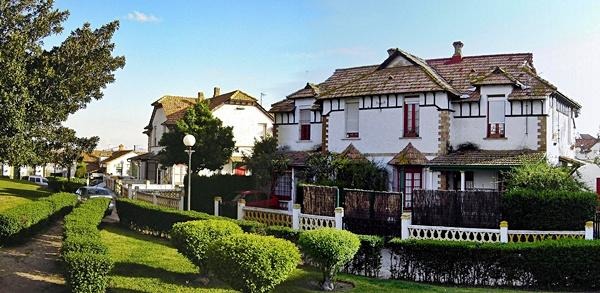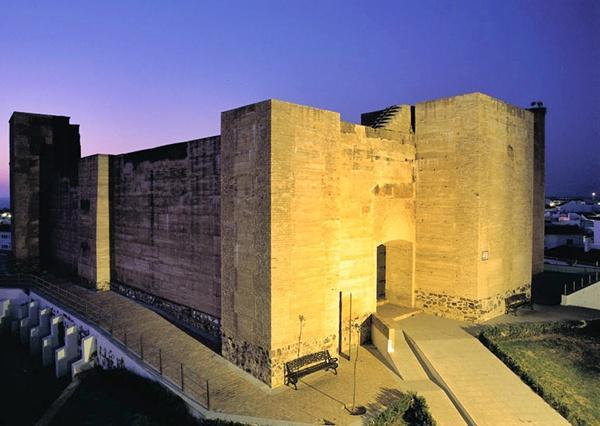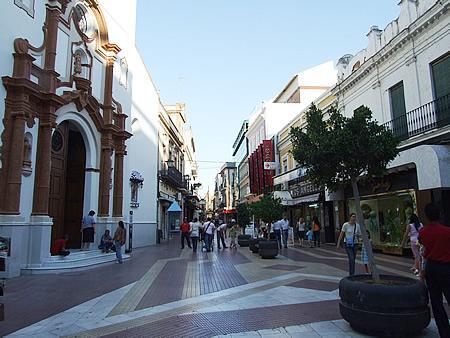Huelva, Andaluzia, Spain
Suggest Place to Visit
3257
Track to location with GPS |
 |
Dolmen of La Zarcita.
Prehistory and Protohistory: Culture of the Huelva bronze, Tartessos and Turdetanos [edit]
There is evidence of human presence in the coastal area of Huelva since the arrival of the first settlers of the Iberian Peninsula through the Strait of Gibraltar. These men gradually settled and occupied the northernmost area.
From the Neolithic, there is evidence thanks to the existence of sites such as La Dehesa [10] in the El Condado region, in which different carved stones and ceramic remains were found. Dolmens such as Soto and other sites such as El Pozuelo [11] or the remains of a walled city in La Zarcita [12] allow us to date the human presence in these territories.
In the Bronze Age, a well-identified culture appeared in the area that comprises the current province of Huelva. This culture came into contact with the Portuguese Southern Bronze Culture, which is reminiscent of the Culture of El Argar in many of its elements, such as the individualized burials in cists or its smooth ceramics. One of its most characteristic features is its funeral ritual, with collective burials in megaliths and individual burials, with a burial model that also developed in southern Portugal at that time. [13] All this suggests that there must have been some kind of contact between these cultures. [14]
The necropolises in the Andévalo and Sierra Morena are located in areas near pyrite deposits. Slate slabs were used for its covering. [14] Their grave goods are not usually abundant, just a couple of bowls, except in the El Becerro necropolis, in the archaeological zone of Santa Eulalia, where necklace beads and silver jewelery have been found. [13] These remains help to understand the passage through the area of the inhabitants of the province during the Bronze Age.
The findings of the Huelva estuary also date from the final stage of the Bronze Age, which, together with those in the area of the Seminary of the capital, [15] are those that probably make the mouth of the Tinto and Odiel rivers in the area of the peninsula with the earliest continued human presence, dating back to 3000 BC. C. [12] [15] [16] [17]
Approximate area of influence of Tartessos.
The Tartessians were indigenous to the southwest of the peninsula who assimilated elements from other cultures, mainly the Phoenicians and the Greeks, who had a relative presence in those lands. Contact with the Greeks coincided with the rise of this culture in the 6th century BC. C. and allowed a cultural takeoff thanks to the trade in metals from the northern mines. Traditions and myths moved various fans and researchers, [18] such as Adolf Schulten or Jorge Bonsor, [18] [19] to search the area, between the Guadiana and Guadalquivir rivers, for treasures that were attributed to this town. Although no important remains have been found that clearly identify their territory or whether it had a governing city, it has been archaeologically verified that an advanced Early Bronze culture flourished in these lands with metallurgical, agricultural and grazing activities; and that he traded with the eastern Phoenicians and Greeks at the dawn of the Final Bronze Age. [20]
It seems that the arrival of the Phoenicians and, later, of the Greek trade did not produce a generalized progress in the Tartessian people and their economy continued to be based on agriculture, livestock and fishing, since the benefits of trade and metallurgy remained in hands of minority social sectors. [20] Archaeological sites such as that of Tejada La Vieja or the Cabezo de la Joya necropolis in the city of Huelva, show the mark of this relatively unknown civilization.
The Tartesian kingdom fell into serious decline throughout the 6th century BC. C. The reasons for this disappearance were complex. The fall of Tyro into Assyrian hands produced a liberalization of trade in the western Mediterranean. This fact was taken advantage of by the Greek colony of Massalia, which, via the Rhone inland, contacted the rich mineral deposits in northern Gaul. [21] This fact meant the loss of geostrategic power of Tartessos as an intermediary in trade, which is why the silver route was relegated to the background. The geopolitical situation in the Mediterranean changed with the irruption of Carthage, which reopened the old Phoenician trade routes. The battle of Alalia supposed the Carthaginian supremacy against the Greek and the crisis of the Greek colony of Massilia. [22] Carthage relaunched the mineral trade in the Tartessos region, but this time controlled by the Punic colony of Gádir. [23] The Tartessian people totally lost control of trade and even their independence with the Carthaginian conquest of the southern peninsula. Already in these times the Tartessian people were known as Turdetan.
The Turdetans, historical descendants of Tartessos and of their same ethnic roots, lived in practically the entirety of the current province and were considered by Strabo as ´´the most cultured of the Iberians´´. [24] Cities like Onuba and Ilipla had great importance in this area.
Pedestal from Roman times found in 1820 in Villarrasa.
Ancient Age: Roman Beturia and Beturia [edit]
Main articles: Baetica and Beturia
In Roman times, the current province of Huelva was in the regions known as Beturia Céltica and Túrdula, within the Roman senatorial province of Baetica. [25] The most important cities of that time were Ilipla (present-day Niebla), Onuba Aesturia (Huelva), Arucci Vetus and Turobrica, both in the Aroche area. These cities lived mainly from mining and maritime trade, like Tartessos.
The Romans built the first infrastructure in the province and exploited the mining regions more efficiently than ever before, experiencing a period of splendor that they do not enjoy even today, since provincial mining is no longer the thriving company of yesteryear. Until contemporary times, this systematic exploitation of mineral resources has not been equaled. Today the dumps of unusable waste from Roman activities can be seen in the current mines, [26] which are currently usable thanks to the best techniques for separating the gangue.
The fall of the Roman Empire in the 5th century eventually allowed the Visigoth peoples to settle in the area.
From the Middle Ages to the end of the Old Regime [edit]
Visigothic period [edit]
With the Roman imperial power collapsed, the Visigoths, former federated of Rome, advanced on the region, causing a power vacuum that the Hispano-Romans tried to avoid by placing themselves in the hands of Byzantium, in the so-called province of Spania. This provoked struggles that lasted throughout the 6th century. [27] [28]
The province of Huelva is a Spanish province located in the west of the autonomous community of Andalusia and its capital is the city of Huelva. With a population of 512,366 inhabitants, [1] it limits to the north with the province of Badajoz, to the east with the province of Seville, to the southeast with the province of Cádiz, to the south with the Atlantic Ocean and to the west with Portugal.
It was constituted as a province in the administrative division of 1833, [2] conforming to territories until then assigned to the old province of Extremadura and the Kingdom of Seville. Administratively, it is divided into 79 municipalities, grouped into 6 judicial districts. [3]
Its economy, as in the rest of Spain, is dominated by the tertiary sector (57% of GDP), which includes tourism. The secondary sector has a greater relative weight than in the rest of Andalusia due to the important Chemical Pole (linked to mining) and the La Rábida refinery. Among the activities of the primary sector are fishing, one of its traditional and main livelihoods with one of the most important fishing fleets in Spain, and the new forced agriculture under plastic, mainly strawberries with designation of origin. Also, within the primary sector, Iberian montanera pig farming has a great tradition and economic importance, highlighting the D.O. Ham from Huelva for its high quality and acceptance in the market. [4]
It has a multitude of protected areas, highlighting the Sierra de Aracena and Picos de Aroche Natural Park and the Doñana National Park, considered the largest ecological reserve in Europe. [5]
Since the Upper Paleolithic there is evidence of human settlements, having inhabited this territory numerous peoples and cultures, [6] such as the Phoenicians, Tartessians, Turdetans, Romans, Visigoths, Muslims and Christians. Several of these peoples coexisted with each other at some times and contributed the richness of their cultures that has shaped the idiosyncrasy of this province.
In the 13th century, the territory of the current province of Huelva was incorporated into the Crown of Castile, organizing itself into realengos and manors, among which the County of Niebla stands out, possession of the House of Medina-Sidonia, along with other organized fiefdoms around Huelva, Palos de la Frontera, Moguer, Ayamonte and Gibraleón. Since then, the province has had a notable historical relevance thanks to its special maritime enclave, its proximity to the border with Portugal, its mining basin and the wealth of resources in the mountains. Although the fact that stands out among all is the discovery of America, which took place in these lands, where Christopher Columbus arrived in 1485 and where he organized his first discovery trip. Men like the Pinzón brothers, the Niño and the Franciscans of La Rábida were fundamental in the success of the company.
Art, culture and traditions [edit]
See also: Columbian places, Gruta de las Maravillas and Fandango (dance)
The Huelva culture, the fruit of the different peoples that passed through the area, is rich in traditions, festivals and celebrations. The Christian tradition has fostered a large number of celebrations of a religious nature, however cultural events related to Americanism and the history of the province also stand out. Among them are:
Monastery of La Rábida, in Palos de la Frontera.
Artistic heritage [edit]
Huelva has a very rich historical-artistic catalog in its province, both religious (in which there are many Christian temples, hermitages and sanctuaries and even old mosques from the time of Muslim domination and later converted into churches) as well as civil, the result of passing through the land of different cultures
Of special interest are the Historic-Artistic Complex of the Columbian Places, [153] all the buildings or infrastructures that appear related to the industrial and mining architecture of the 19th century and the fortifications and castles that flourished throughout the Middle Ages, being an important border enclave with Portugal. Among the most outstanding monuments in Huelva, the most valuable, listed by locality, are:
Religious monuments [edit]
Almonaster Mosque.
Of the mountain town of Almonaster la Real, the church-mosque built in the first decades of the 10th century and whose mihráb is one of the oldest in Spain is essential. [158]
Church of Our Lady of Granada (Niebla).
In the capital of the mountains, Aracena, the Priory Church of Nuestra Señora de los Dolores stands out. It was built in the 15th century and declared a Site of Cultural Interest in 1995. [159]
The border town of Ayamonte is home to the Church of Nuestro Señor y Salvador, from the 15th-18th century, [160] Mudejar style and built in the oldest neighborhood of the city. Inside are important works of Flemish origin.
From Huelva capital: highlights the environment and Sanctuary of Our Lady of La Cinta, on the Cabezo del Conquero; This temple was visited by Christopher Columbus to thank the favors granted during his journey and inside it houses the Patron Saint of the city from which it takes its name. [109] Also important are the Church of San Pedro, built on the remains of a mosque and at the foot of a castle that has now disappeared, which, due to its important heritage, has been declared an Asset of Cultural Interest. [161] Or the former convent and now Iglesia Catedral de la Merced, also declared a monument of Asset of Cultural Interest, [162] which is located next to one of the university's headquarters.
Monastery of Santa Clara, in Moguer.
The religious tradition in Moguer is evident in the Monastery of Santa Clara. This National Monument was visited by Cristóbal Colón [163] to fulfill the so-called Columbian vote. In turn, the Parish Church of Nuestra Señora de la Granada [164] (from the 18th century), whose tower is reminiscent of La Giralda in Seville, the Convent of San Francisco (15th-18th centuries) and the Hospital del Corpus Christi (18th century) stand out. XIV).
In La Redondela, there is the Parish Church of Our Lady of the Twelve Apostles, dated in the 15th century, with its last extension in 1795 and recently restored.
The walled city of Niebla is home to the Church-mosque of Nuestra Señora la Granada, a jewel of Christian architecture from the 10th century, to which the faithful flocked during the years of Muslim domination until the Almohads transformed it into a mosque. It was declared a historical artistic monument in 1931. [165]
La Palma del Condado: the Church of San Juan Bautista, from the 18th century.
Church of San Jorge Mártir, in Palos de la Frontera.
From Palos de la Frontera, a key town in the provincial history, the Monastery of La Rábida, from the 14th-15th centuries, stands out. He was visited by Christopher Columbus on several occasions, during which he received support and made the first of his trips. It was declared a National Monument in 1856 [166] and declared the First Historic Monument of the Hispanic Peoples. [167] Also important is the Church of San Jorge Mártir, from the 15th century, where the Royal Provision [168] of the Catholic Monarchs was read, ordering Diego Rodríguez Prieto, and other residents of the town of Palos, to have two caravels prepared to leave with Christopher Columbus. Declared a National Monument in 1931. Both temples are in the Gothic-Mudejar style.
In the small village of El Rocío, in Almonte, the Hermitage of El Rocío is essential, important not only for its artistic value, but also because it represents one of the most important Marian events in the world. [169] This temple, built in 1963, replaced previous ones that had become too small due to the influx of pilgrims.
Civil monuments [edit]
Monument to the Discovery Faith.
In the town of Almonte there is the watchtower of la Higuera. Truncated on the beach in Matalascañas since 1755 as a result of the Lisbon earthquake, it is one of the typical pictures of the Huelva coast. [170] This type of construction - common on the Huelva coast - was essential for defense and surveillance against frequent pirate incursions.
In Aracena, although it is a natural monument, the Gruta de las Maravillas stands out for its conditioning of lights and sounds and its access in the urban center. Formed under the limestone rocks of Cerro del Castillo, this cave is one of the most visited places in Huelva. It was declared a natural monument.
The town of Cortegana appears dominated by its castle, from 1293. [171] This fortress is one of the best preserved in the province.
The same occurs in Cumbres Mayores, where the castle-fortress of Sancho el Bravo has been a National Historic Monument since 1895. It is a clear example of defensive architecture against the Portuguese. [172] Although it began to be built in 1293, it was not finished until the beginning of the 14th century.
Muelle del Tinto, in Huelva.
In the city of Huelva, the Monument to the Discovery Faith stands out, a large cubist sculpture raised in 1929 in honor of the feat of the discoverers of America, [173] and two well-known examples of the Anglo-Saxon period in the city: Barrio Reina. Victoria, in the English style of the early 20th century, built to accommodate the employees of the mines in the city, and the Muelle del Tinto, from the late 19th century, built to facilitate the unloading of mineral to the ships of the Port of Huelva and recognized Asset of Cultural Interest. [174]
Modernism on the coast: the most popular building in Isla Cristina, Gildita's house.
In the municipality of Isla Cristina, the 18th century dovecot of the Huerta Noble is worth noting. It is the largest dovecote in southwestern Europe. It houses about thirty-six thousand pigeon nests and has its origins as an agrarian-industrial complex
Comments
We don´t have yet any comments about:
Huelva
Huelva
Be the first to leave a comment as it is very important to inform other people
Outros locais a visitar
Within a radius of 20 km from:Huelva
Arènes de La Merced (Huelva) |
| 0,9 Km |
 |
Barrio Reina Victoria |
| 0,9 Km |
 |
Château - Forteresse Zúñigas (Cartaya) |
| 18,6 Km |
 |
Hotel reservation near Huelva within a radius of 20 km
Why to book with ROUTES TOURISTIQUES
The best prices
Our partnerships with the world´s largest operators offer research on the best market prices.
More options
At Rotas Turisticos you can book the hotel, buy the air ticket, book the transfer from the airport to the hotel and vice versa, book the local excursions, rent the car, take travel insurance and consult the places to visit and where to go.
Holiday Tips & Destinations
Hundreds of holiday destinations with all the options that allow you to easily choose the destination that best suits your dream vacation.
ROUTES TOURISTIQUES
Links






